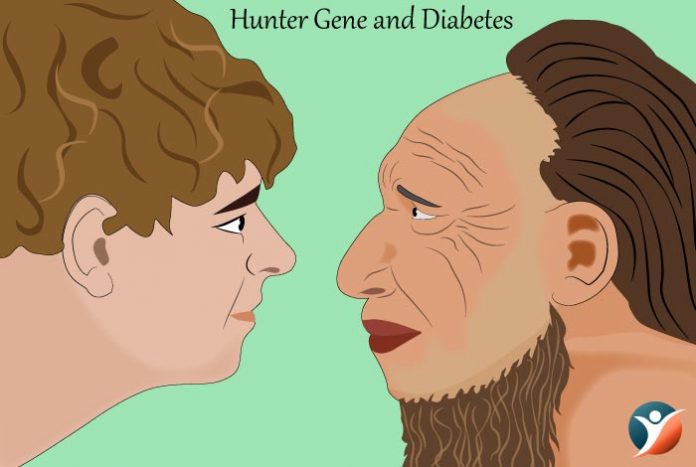
Table of Contents
- Neanderthals and the Modern Man
- Neanderthal Genes in Modern Man’s Genome
- Characteristics of ‘Hunter’ Gene
- How Hunter Genes Affect Human Population?
- Role of SLC16A11
- Conclusion
Neanderthals and the Modern Man
Hundreds and thousands of years ago, when Neanderthals roamed on this planet, hunting was their main source of food. They were excellent tool makers and great hunters. Modern humans co-existed with them and it is thought that they Neanderthals and the early humans mated a long time ago and gave rise to Homo sapiens lineage. From there, the ‘hunter’ gene got introduced in the modern human population. It is even believed that the Neanderthal genes might be the reason for all the human progress.
Neanderthal Genes in Modern Man’s Genome
Even today, we are carrying Neanderthal genes in our genetic pool and there are evidences that indicate that if these genes get activated, it can give certain characteristics to the humans that point towards our hunter lineage. As per the recent discovery, we are carrying so much Neanderthal genes that we are yet to recognize its full potential.
Characteristics of ‘Hunter’ Gene
Hunters required some peculiar characteristics in order to be an avid hunter, such as:
- short attention span
- distorted sense of time
- impulsiveness
- poor planning and organizing skills
- attraction to novelty
- hyper focus
Along with this, you can blame the Neanderthal gene for giving you diabetes. There have been extensive studies done in order to show some light on this hypothesis.
The genomes of hundreds and thousands of Asians and Europeans were compared to the Neanderthal DNA from the toe bone. Of the 1 to 4% of non-African genetic make-up which is thought to have come from Neanderthals, it was found that large amounts of Neanderthal DNA were found in the hair and skin genes. It suggested that the Neanderthal DNA influenced tougher, thicker hair and skin, lighter skin color that was more suitable for surviving in the cooler, darker environment of Eurasia.
It is also believed that a number of diseases like depression, diabetes and autoimmune disorders like lupus, Crohn’s disease and biliary cirrhosis came from the Neanderthals.
Previously, it was not clear how these genes actually came into play, but now we have a few leads in this direction.
How Hunter Genes Affect Human Population?
Around 1004 genomes of modern humans were screened and different regions bearing the Neanderthal versions of genes were identified. Surprising results were obtained from this study.
There is no evidence that proves whether or not our Neanderthal cousins suffered from these diseases or not, or, whether these mutations show their effect only in modern humans.
Another study done on the Latin American population described that a gene variant that is known to cause diabetes has a high frequency in the population. Those people who carried the higher risk version of the gene were found to be 25% more likely to develop diabetes than those who did not. Additionally, those who inherited this the copy of the gene from both the parents were 50% more likely to get the disease. The higher risk version of the gene is found in nearly half of the people with recent Native American ancestry and has been named SLC16A11.
Role of SLC16A11
Neanderthal is a northern species whereas modern humans are essentially a sub-Saharan African species. Since Neanderthals had origins in cold climate, their DNA promoted storage of fat and other metabolic as well as immune system adaptations that made it easier for them to survive in chilly temperatures.
When African humans moved north, there was interbreeding between them which gave rise to the modern man who went on to populate Asia and Europe. As humans went on to inhabit other areas with harsher climates, their genomes latched more and more onto Neanderthal variants that helped them to survive.
The researchers discovered a gene that increases the chances of developing type II diabetes in people, known as SLC16A11. This gene gets activated in the liver and people who have this gene are 25% more likely to develop diabetes than those who do not have this gene.
Scientists discovered that the levels of protein encoded by this gene alters the amount of a specific type of fat that has been linked to play a major role in increasing the risk of type II diabetes.
SLC16A11 belongs to a family of genes that is involved in coding proteins that help in transporting metabolites. When the levels of SLC16A11 protein are altered, the amount of fat a particular fat changes, which is known to increase the risk of developing diabetes. These observations indicate that SLC16A11 could play an important role in developing diabetes.
A variant form of the gene SLC16A11 is found in about 20% of East Asians, while its frequency is quite rare in populations in Europe and Africa. This gene sequence has been discovered in the newly sequenced Neanderthal genome.
One study also pointed out that Neanderthal DNA promoted elevated levels of LDL cholesterol, which is the good kind of cholesterol.
However, it is extremely difficult to ascertain the actual ties between Neanderthal DNA and diseases like gestational diabetes.
Conclusion
One of the most exciting aspects of discovering the link between diabetes and the hunter genes is we have uncovered new and exciting aspects behind biology of diabetes, a disease that is gradually becoming a global epidemic. Scientists believe that this discovery will help in assessing risk and develop novel treatment methods for diabetes.




